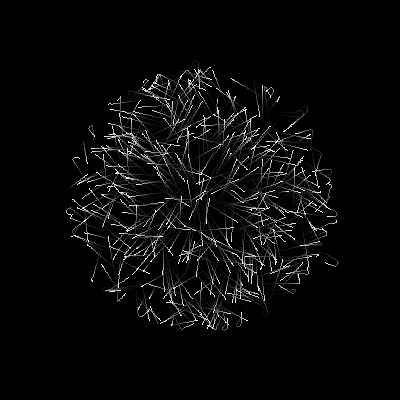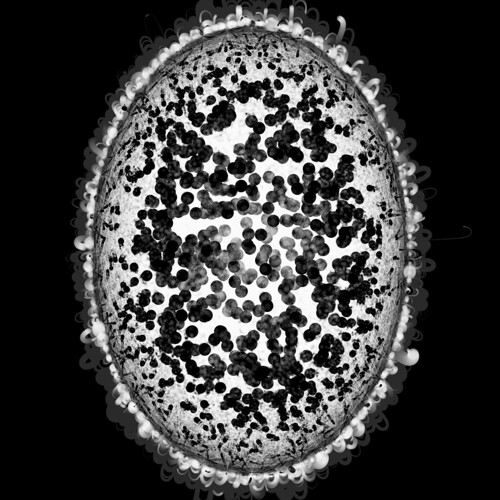-
var resolution:Number = .03;
-
var pointNum:int = Math.ceil(1 / resolution);
-
-
var bezA:Array = new Array();
-
populateArray(bezA);
-
var a:Sprite = dot(100, 200);
-
var b:Sprite = dot(200, 100);
-
var c:Sprite = dot(300, 200);
-
-
var bezB:Array = new Array();
-
populateArray(bezB);
-
var d:Sprite = dot(300, 100, 0xCCCC00);
-
var e:Sprite = dot(120, 130, 0xCCCC00);
-
var f:Sprite = dot(200, 300, 0xCCCC00);
-
-
addEventListener(Event.ENTER_FRAME, onLoop);
-
function onLoop(evt:Event):void {
-
with(graphics){
-
clear();
-
lineStyle(0, 0x000000);
-
-
// calc and draw bezier points
-
drawBezier(bezA, a, b, c);
-
drawBezier(bezB, d, e, f);
-
-
// calc collisions
-
var intersections:Array = calculateIntersection(bezA, bezB);
-
-
// draw collisions
-
beginFill(0xFF0000);
-
if (intersections.length> 0){
-
for (var i:int = 0; i<intersections.length; i++){
-
drawCircle(intersections[i].x, intersections[i].y, 3);
-
}
-
}
-
endFill();
-
}
-
}
-
-
function populateArray(a:Array):void {
-
for (var i:int = 0; i<pointNum; i++){
-
a.push(new Point());
-
}
-
}
-
-
function drawBezier(bez:Array, a:Sprite, b:Sprite, c:Sprite):void{
-
with(graphics){
-
bezier(bez, a.x, a.y, b.x, b.y, c.x, c.y);
-
var leng:Number = bez.length;
-
moveTo(bez[0].x, bez[0].y);
-
for (var i:int = 1; i<leng; i++){
-
lineTo(bez[i].x, bez[i].y);
-
}
-
}
-
}
-
-
function bezier(bez:Array, x1:Number, y1:Number, x2:Number, y2:Number, x3:Number, y3:Number):void {
-
var b:Number, a2:Number, ab2:Number, b2:Number;
-
var pnt:Point;
-
var inc:int = 0;
-
for (var a:Number = 0; a <=1; a+=resolution) {
-
b= 1 - a;
-
a2 = a * a;
-
ab2 = a * b * 2;
-
b2 = b * b;
-
pnt = bez[inc];
-
pnt.x = a2 * x1 + ab2 * x2 + b2 * x3;
-
pnt.y = a2 * y1 + ab2 * y2 + b2 * y3;
-
inc++;
-
}
-
}
-
-
function calculateIntersection(bezA:Array, bezB:Array):Array {
-
var intersections:Array = new Array();
-
var ip:Point;
-
var aLength:int = bezA.length;
-
var bLength:int = bezB.length;
-
var p1:Point, p2:Point, p3:Point, p4:Point;
-
-
// compare all line segments and check for
-
// intersections
-
for (var i:int = 1; i<aLength; i++){
-
p1 = bezA[i - 1];
-
p2 = bezA[i];
-
for (var j:int = 1; j<bLength; j++){
-
p3 = bezB[j - 1];
-
p4 = bezB[j];
-
ip = intersection(p1, p2, p3, p4);
-
if (ip){
-
intersections.push(ip.clone());
-
}
-
}
-
}
-
return intersections;
-
}
-
-
var ip:Point = new Point();
-
-
function intersection(p1:Point, p2:Point, p3:Point, p4:Point):Point {
-
-
var nx:Number, ny:Number, dn:Number;
-
var x4_x3:Number = p4.x - p3.x;
-
var pre2:Number = p4.y - p3.y;
-
var pre3:Number = p2.x - p1.x;
-
var pre4:Number = p2.y - p1.y;
-
var pre5:Number = p1.y - p3.y;
-
var pre6:Number = p1.x - p3.x;
-
-
nx = x4_x3 * pre5 - pre2 * pre6;
-
ny = pre3 * pre5 - pre4 * pre6;
-
dn = pre2 * pre3 - x4_x3 * pre4;
-
-
if (dn == 0){
-
return null
-
}
-
nx /= dn;
-
ny /= dn;
-
// has intersection
-
if(nx>= 0 && nx <= 1 && ny>= 0 && ny <= 1){
-
ny = p1.y + nx * pre4;
-
nx = p1.x + nx * pre3;
-
ip.x = nx;
-
ip.y = ny;
-
}else{
-
return null;
-
}
-
return ip
-
}
-
-
// draggable dot
-
function dot(xp:Number, yp:Number, col:uint = 0x507399, noDrag:Boolean = false):Sprite {
-
var s:Sprite = Sprite(addChild(new Sprite));
-
s.x = xp;
-
s.y = yp;
-
with(s.graphics) beginFill(col), drawCircle(0,0,5);
-
if (!noDrag){
-
s.buttonMode = true;
-
s.addEventListener(MouseEvent.MOUSE_DOWN, onDrag);
-
}
-
return s;
-
}
-
function onDrag(evt:MouseEvent):void {
-
evt.currentTarget.startDrag()
-
}
-
-
stage.addEventListener(MouseEvent.MOUSE_UP, onUp);
-
function onUp(evt:MouseEvent):void{
-
stopDrag();
-
}

